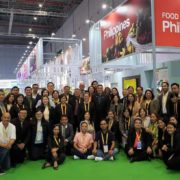
Shanghai, China – Philippine exhibitors booked around USD 300M in sales at the 2nd China International Import Exposition (CIIE), more than twice the USD124 M recorded sales last year. Top sellers were fresh bananas, pineapples, mangoes and durian; not to be outdone were processed fruits and nuts, and other coconut-based products.
“The big jump in sales since the last CIIE proves that the China sees the Philippines as a significant source of agricultural and other products. This motivates us to continue our efforts in getting more exhibitors to the CIIE, as well as improving trade relations and market access through the conclusion of the Regional Comprehensive Economic Partnership (RCEP). Suppliers, on their part, should increase their production to answer the demand of the Chinese market,” said Department of Trade and Industry (DTI) Secretary Ramon Lopez.
Sec. Lopez led a 139-strong Philippine delegation, with 32 food exhibitors participating this year. With the huge opportunity in the Chinese food market, Sec. Lopez has advocated for continued, stronger and effective presence in the CIIE through strategic positioning of Philippine products to serve the upgraded requirements of Chinese consumers.

Since it began last year, the CIIE 2019 is a trade fair held in autumn in Shanghai and is the world’s first import-themed national-level expo. The total exhibition area of the CIIE exceeds 240,000 square meters and attracts an average of 150,000 professional buyers, with more than 100 participating countries. Amidst these immense numbers, Philippine products—known to be of quality to foreign buyers– received overwhelming approval at the CIIE.
Many Chinese buyers and consumers lined up to try the various food products offered at the Philippine Food Pavilion consisting of 32 exhibitors, including premium tuna products recently launched in the Chinese market by Century Pacific and other products by Philippine global brands such as San Miguel, Monde Nissin, and Fisher Farms.
Chef Bea Nitard of Via Mare used Philippine ingredients to prepare dishes suitable to the Chinese palate. The chef observed that the Chinese are not afraid to try new things and the Philippines should introduce more premium food products to the Chinese consumers. The popularity of the dishes was apparent in the long lines seen at the Food Philippines Pavilion every day.

The Philippine pavilion was formally opened by the DTI Undersecretary Abdulgani Macatoman, with China’s Ministry of Commerce Director General Peng Gang. In his opening remarks, Undersecretary Macatoman highlighted the role of the 32 Philippine exhibitors in contributing to the growth of Philippine exports in China’s food sector, especially in the fresh fruits category. The Philippines currently exports mangoes, bananas, papayas, pineapples, and young coconuts. But Undersecretary Macatamon observed that with the stronger Philippine-China relations and through China’s liberalization program and the CIIE, there will be more Philippine food products sold in China soon.
The Philippine participation was organized by DTI through the Center for International Trade Expositions and Missions (CITEM). It was supported by the Export Marketing Bureau (EMB) and the Foreign Trade Service Corp (FTSC) through the Philippine Trade and Investment Centers (PTICs) in Shanghai, Beijing, and Guangzhou in partnership with the Department of Agriculture (DA), the Agribusiness and Marketing Assistance Service (AMAS), and the Office of the Agricultural Counsellor in Beijing.
With the positive feedback and results generated from the Philippine participating companies and keen interest shown by Chinese buyers, DTI and DA expect a much bigger participation in the next edition of the CIIE in 2020.
—
Stay updated with news and information from the Department of Trade and Industry by visiting their website at dti.gov.ph.





